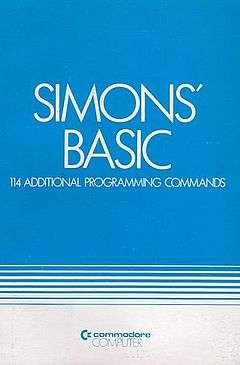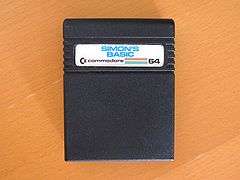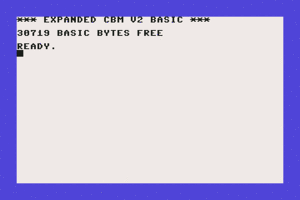Simons' BASIC
- This product is widely, but incorrectly, called "Simon's BASIC", because of confusion between the first name "Simon" and the surname "Simons".
|
The Simons' BASIC start-up screen. Note the altered background and text colours (vs the ordinary C64 blue tones), and the reduction of available BASIC program memory by the 8 KB used by the cartridge (memory-mapped). | |
| Original author(s) | David Simons |
|---|---|
| Developer(s) | Commodore |
| Initial release | 1983 |
| Written in | BASIC 2.0 |
| Operating system | Commodore 64 |
| Type | extension |
Simons' BASIC was an extension to BASIC 2.0 for the Commodore 64 home computer. Written by 16-year-old British programmer David Simons in 1983, it was distributed by Commodore in cartridge format.


Features
Simons' BASIC added 114 additional keywords to BASIC 2.0.[1] These included commands to ease the coding of sprites, high-resolution and multicolour graphics, and sound. In addition, commands were also implemented to aid in structured programming. Keywords to assist in writing and editing BASIC programs, similar to those in the VIC-20 Programmer's Aid cartridge, were also included. Also, programs written in Simons' BASIC could employ hexadecimal numbers in assignments and calculations by including a $ prefix, or binary numbers by utilizing a % prefix.
Because a portion of the cartridge data was mapped into memory at addresses $8000–$9FFF, which overlapped part of the standard C64 BASIC RAM, the amount of available memory for BASIC programs was 8 KB less than that of a standard C64 configuration.
A further extension to the Commodore V2 Basic was also written by Simons and released by Commodore on floppy disk as Simons' Basic 2. It could not be released on cartridge because the original Simons' Basic cartridge had to be present in order to use the extension. Simons' Basic 2 added 91 extra commands including a much coveted RENUMber command which also took care of renumbering the destinations of GOTO and GOSUB statements.[2]
The 114 keywords
Sprite (MOB) handling keywords
- MOB SET – enables a sprite and defines its attributes
- MMOB – positions a sprite on the screen
- RLOCMOB – causes a sprite to smoothly move from one location to another
- CMOB – sets up the two global colours for multicolour sprites
- MOB OFF – disables a sprite
- DETECT – initializes sprite collision detection
- CHECK – checks for a sprite collision
High resolution graphics handling keywords
- HIRES – initializes a high-resolution graphics mode
- MULTI – initializes a multicolour graphics mode
- NRM – returns to the text display
- LOW COL – changes the plotting colours
- HI COL – returns to the original plotting colours
- PLOT – draws a pixel
- LINE – draws a line
- CIRCLE – draws a circle
- ARC – draws an arc
- ANGL – draws the radius of a circle
- PAINT – performs a flood fill
- REC – draws a hollow rectangle
- BLOCK – draws a solid rectangle
- DRAW – draws a user-defined set of lines
- ROT – sets scaling factors for DRAW
- CHAR – plots a text character on a high-resolution screen
- TEXT – plots a text string on a high-resolution screen
- TEST – determines whether a pixel is plotted or empty
Other graphics handling keywords
- COLOUR – sets the background and border colours
- CSET – selects a character set
- MEM – copies character ROM to RAM
- BCKGNDS – configures extended background colour mode
- FLASH – sets up a screen colour to flash
- OFF – cancels a previous FLASH directive
- BFLASH – causes the screen border to flash
- FCHR – fills an area of the text screen with a given character code
- FCOL – changes character colours for a selected area of the screen
- FILL – a combination of FCHR and FCOL
- MOVE – copies a section of the screen
- INV – displays a screen area in reverse
- LEFT – scrolls the screen left
- RIGHT – scrolls the screen right
- UP – scrolls the screen up
- DOWN – scrolls the screen down
- GRAPHICS – reserved variable that always equals $D000 (the VIC-II chip's base address)
Sound handling keywords
- MUSIC – plays a series of notes based on the contents of a string variable
- PLAY – determines whether the program continues to run during MUSIC
- VOL – specifies the master sound volume
- WAVE – specifies a voice type
- ENVELOPE – sets ADSR parameters for a SID voice
- SOUND – reserved variable that always equals $D400 (the SID chip's base address)
Keyboard input handling keywords
- FETCH – takes user input with restrictions defined by the command
- INKEY – checks for a function key press
- ON KEY – checks for a given keypress, then performs a branch if present
- DISABLE – disables the previous ON KEY directive
- RESUME – reenables the previous ON KEY directive
Input peripheral handling keywords
- JOY – reads a joystick
- POT – reads a paddle
- PENX – reads the light pen's horizontal position
- PENY – reads the light pen's vertical position
Sprite/custom character definition keywords
- @ – describes one line in a sprite or custom character graphic
- DESIGN – uses neighbouring @ lines to define a sprite or custom character
Error trapping keywords
- ON ERROR – sets up a routine to trap error conditions
- OUT – ends an error handling routine
- NO ERROR – cancels ON ERROR and restores normal BASIC error handling
Disk handling keywords
- DIR – displays the disk directory without destroying the BASIC program in memory
- DISK – sends a string to the disk drive's command channel
- SCRSV – saves a text screen to disk
- SCRLD – loads a text screen from disk
Printer handling keywords
- HRDCPY – sends the text screen to the printer
- COPY – sends the high-resolution screen to the printer
String manipulation keywords
- INSERT – inserts one string into the middle of another
- INST – similar to INSERT, but overwrites rather than inserting
- PLACE – searches for one string in the middle of another
- DUP – duplicates a character string a given number of times
Text formatting keywords
- AT – prints a string at a given screen location
- CENTRE – centres a character string on the screen
- USE – formats numeric data in strings based on a template
- LIN – returns the vertical position of the cursor
Maths keywords
- MOD – performs a division operation and returns the remainder
- DIV – performs a division operation and returns the integer quotient
- FRAC – isolates the fractional portion of a number
- EXOR – performs an exclusive-OR logical operation
Programmer's aid keywords
- AUTO – automatically generates line numbers as a BASIC program is entered
- RENUMBER – renumbers a BASIC program (but does not fix GOTO/GOSUB statements)
- OLD – undeletes a program accidentally removed by the NEW command
- KEY – assigns a string as a macro to a function key
- DISPLAY – displays all function key macros
- MERGE – merges a BASIC program from disk into the program currently in memory
- PAGE – displays a BASIC program listing in page format
- OPTION – highlights Simons' BASIC keywords when using the LIST command
- DELAY – varies the rate at which the LIST command scrolls the screen
- FIND – searches the program for a string
- TRACE – displays the line numbers as a program is running
- RETRACE – displays results of a trace
- DUMP – displays all variable values except for arrays
- COLD – resets the C64
Security-related keywords
- DISAPA – marks a BASIC program line for hiding
- SECURE – hides all lines marked with DISAPA so that they cannot be viewed with LIST
Structured programming keywords
- ELSE – allows an alternative branch for IF/THEN conditionals
- REPEAT – start of a REPEAT/UNTIL loop structure
- UNTIL – defines the loop condition for a REPEAT/UNTIL loop structure, and marks its end
- RCOMP – recapitulates the last IF/THEN conditional
- LOOP – defines the start of a loop that will run until an EXIT IF conditional is true
- EXIT IF – the conditional is true, so it exits the current LOOP/END LOOP structure
- END LOOP – defines the end of a loop that will run until an EXIT IF conditional is true
- PROC – defines the start of a named subroutine
- END PROC – defines the end of a named subroutine
- CALL – jump to a named subroutine defined with PROC/END PROC, and stay there
- EXEC – call a named subroutine defined with PROC/END PROC, then return
- LOCAL – redefines variables for use in structures
- GLOBAL – reverses the effects of a previous LOCAL command
Miscellaneous keywords
- CGOTO – equivalent to GOTO, but accepts calculated expressions
- RESET – moves the DATA pointer to a given line number
- PAUSE – pauses program execution for a specified number of seconds
Other
- $ and % are also considered keywords, for a total of 114.
Trivia
The band Barcelona titled their 1999 debut album Simon Basic in tribute. The album includes the song "C-64".
Reception
Creative Computing stated that Simons' BASIC "almost makes the 64 into a new computer. (Probably the one it should have been in the first place.)" It praised the "very fine manual" as a contrast to Commodore's usually poor documentation, and predicted that it would become "the standard language for programming the machine … Commodore had better be planning to manufacture lots of copies because they will go fast".[3] Ahoy! wrote "If you do any programming in BASIC and should happen to see this product on a dealer's shelf, do not ask any questions—do not hesitate—just buy it!" The magazine praised Simons' BASIC's power and "excellent manual", and stated that "its price makes it one of the biggest bargains available for the Commodore 64".[4] RUN's review was less favorable, stating that its "many powerful and useful commands … were, unfortunately, implemented very poorly for a commercial package. There is very little command parameter checking, and many things have been overlooked or ignored."[5]
References
- ↑ Simons' Basic User Manual (Published by Commodore)
- ↑ Simons' Basic 2 User Manual (Published by Commodore)
- ↑ Onosko, Tim (1983-11). "Simons' Basic.". Creative Computing. p. 60. Retrieved 27 June 2014. Check date values in:
|date=(help) - ↑ Kevelson, Morton A. (1984-02). "Simons' BASIC". Ahoy!. pp. 57–58. Retrieved 27 June 2014. Check date values in:
|date=(help) - ↑ Baker, Robert W. (1985-04). "A Review of Simons' Basic". RUN. pp. 94–95. Retrieved 27 June 2014. Check date values in:
|date=(help)
External links
- Simons' Basic Italian Reference Guide by David Simons, Commodore Editor, 1983.
- Forum topic with some informal information from David Simons himself.
